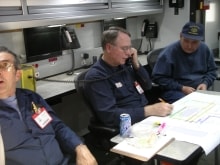Mining Topic: Emergency Management
What is the health and safety problem?
A series of tragic events over the course of a decade demonstrate the need for competency in managing mine emergencies at all levels in the mining community. These events were Brookwood in 2001 (13 fatalities), followed by Sago (2006, 12 fatalities), Darby (2006, 5 fatalities), Aracoma (2006, 2 fatalities), Crandall Canyon (2007, 6 fatalities), and Upper Big Branch (2010, 29 fatalities). The Mine Safety and Health Administration (MSHA) orders mine emergency management requirements for mine operators, including designation and training for responsible persons and the development of mine emergency response plans. To minimize the impact of mine emergencies, it is crucial for companies to be adequately prepared to manage them.
How is the NIOSH Mining program addressing this problem?
Researchers from the Office of Mine Safety and Health Research (OMSHR) have conducted a series of group and individual interviews to learn what happens in the first crucial moments of a mine emergency. The subjects represented underground mines in several commodities and were located throughout the U.S. They included on-site responders, mine rescue team members, and experts in mine emergency response with extensive experience in managing mine disasters. The goal is to learn lessons from these experts that can be passed on to future responders. The loss of critical mine emergency management knowledge as a result of the departure of employees with firsthand experience in mine emergency response has also been explored.
OMSHR has assessed the need for written mine emergency response plans. A variety of plans were studied and guidance was developed for mine operators. Researchers also studied past mine emergencies and used examples from these events to highlight the importance of emergency response planning.
What are the significant findings?

Mine management officials in a command center during a mock mine disaster.
Results from focus groups and interviews about the initial moments of a mine emergency indicate that there are common themes in initial response, which include the importance of mine emergency planning and training, quantity and quality of communication that provides information for decision-making, leadership and trust, and individual personal issues. The findings have resulted in recommendations to enhance initial response in the first critical moments of an emergency.
OMSHR researched and successfully demonstrated the effectiveness of post-incident directional lifelines which are now required.
What are the next steps?
Knowing there will always be the possibility of mine emergency events, it is critical for mine officials at all levels to have the knowledge, skills, and ability to step in and manage response to the event thoroughly and efficiently. Recently, the Mine Rescue and Escape Training Laboratory was created at NIOSH’s Pittsburgh campus. With the inauguration of this laboratory, researchers are poised to investigate how virtual reality (VR) technologies can be used for teaching critical mine emergency response skills including emergency management. As part of this effort, researchers will develop training for command center leaders that incorporates virtual reality components. Broad questions to be answered by this work include:
- How can VR training techniques be used to train command center leaders?
- How can command center training contribute to the development of integrated live, virtual, and constructive training simulation for mine emergency response?
This work will build on past NIOSH findings on command center training, coaching and leadership skills, and crisis decision-making.
- Emergency Response Planning for Small Mines: Who Needs It?
- Emerging Technologies: Aiding Responders in Mine Emergencies and During the Escape From Smoke-Filled Passageways
- Evaluation of the Bagged Stone Dust Barrier Effectiveness in a Bord and Pillar Mine
- Fire Response Preparedness for Underground Mines
- A Human Component to Consider in Your Emergency Management Plans: The Critical Incident Stress Factor
- Knowledge Management and Transfer for Mine Emergency Response
- Leadership Characteristics in Escape from Three Underground Mine Fires
- Mine Emergency Response Command Center Training Using Computer Simulation
- Mobile Adaptable RF/IT Infrastructure - Experimental (MATRIX)
- An Oral History Analysis of Mine Emergency Response
- Refuge Chamber Training Products and Guidance
- A Review of Recent Accidents Involving Explosives Transport
- Training for Safety in Emergencies Inoculating for Underground Coal Mine Emergencies
- Underground Coal Mine Disasters 1900-2010: Events, Responses, and a Look to the Future
- Using the Internet to Train Emergency Command Center Personnel